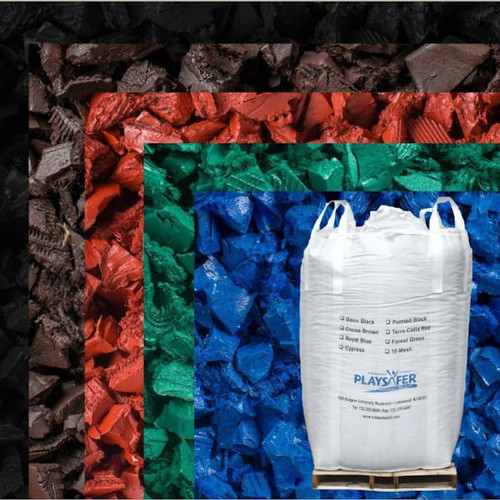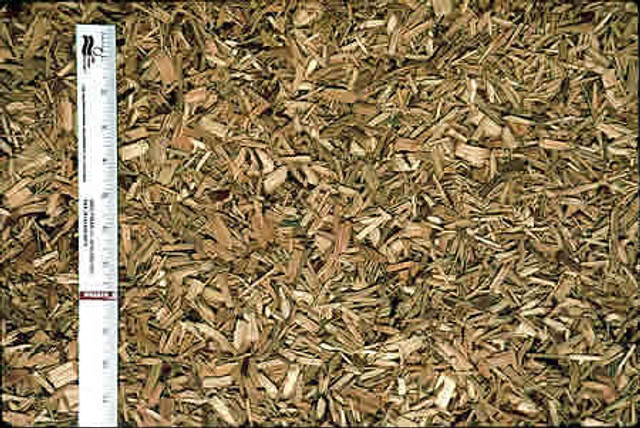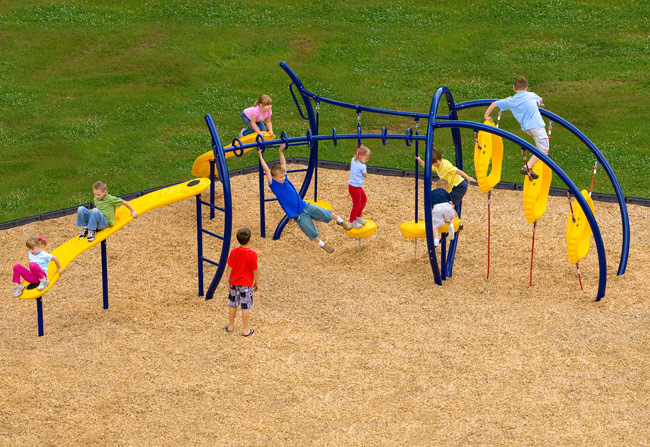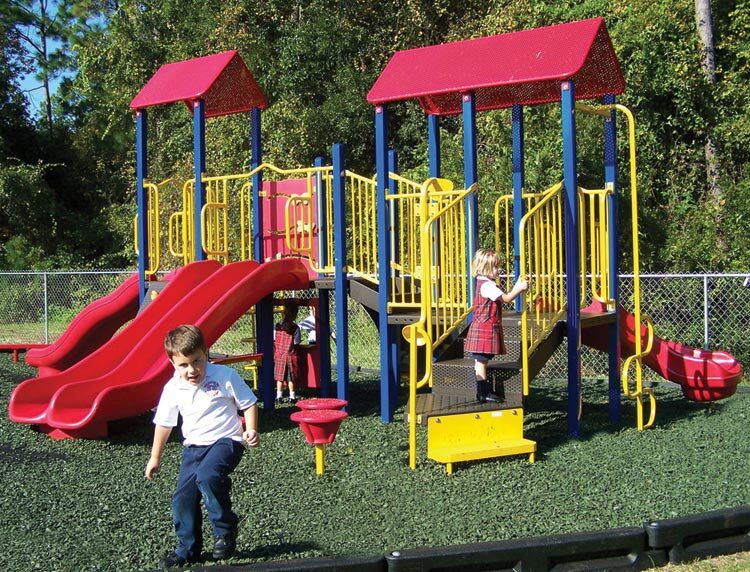-

Action Play Systems
Action Play Systems Plastic Maintenance Free Playground Border with Spike
$25.95 - $43.00 -

-

-

-

-

IMC Outdoor
IMC Outdoor NuPlay Recycled Rubber Playground Mulch (50 Single 40 lb Bags)
$369.00 - $571.00 -

-

-

-

-

-

Surfacing for All Playground Projects
Playground safety surfacing is a crucial part of creating a safe play area for your guests. Safety surfacing is available in a wide range of materials and styles to fit every application and budget. Some of our more popular choices include rubber mulch and poured-in-place surfacing for their superior longevity and durability. Or if you prefer a more natural aesthetic, you may opt for wood mulch or artificial turf.
We also offer playground borders to keep loose-fill materials in place, and ramps to ensure ADA accessibility. Our playground experts will be happy to discuss the various surfacing options to help you decide on the best material for your project.
Choosing the Right Playground Surfacing

Types of Playground Surfacing
Playground Outfitters offers several types of safety surfacing to fit a variety of applications and budgets. We also offer borders and access ramps to keep loose-fill material in place and allow ADA compliant access.

Wood Fiber Mulch
Wood mulch is the most popular option for commercial playground surfacing since it is also the most economical. The wood fibers offer a nice, natural look, but wood mulch does require more maintenance than other types of surfacing due to compaction and decomposition. Maintaining proper depth* of any loose fill surface is important for safety and accessibility compliance. Get a QuoteRubber Mulch / Recycled Rubber
Like wood mulch, rubber mulch is a commonly used loose fill playground surfacing material. Our rubber mulch is made from 100% recycled rubber tires and provides a soft surface that keeps children safe during play time. Rubber mulch is often preferred over its wood counterpart due to its superior drainage and dust minimizing qualities. It is also lower maintenance than wood mulch because it does not compress or decompose over time, so it requires less frequent top-offs. Shop Rubber MulchRecycled Bonded Rubber
Consisting of clean recycled shredded rubber that is coated and mixed with a polyurethane binder, recycled bonded rubber is known for its value and durability. It’s is a great option for highly accessible paths and external walkways and can be poured at different depths to account for various fall heights. With little maintenance required, this is a great option for today’s playgrounds. Get a QuoteSynthetic Turf or Artificial Grass
Synthetic grass is quickly becoming a popular choice for playground surfacing because it is easy to maintain and cost effective. Conventionally, it provides the look of real grass, but does not require mowing or additional maintenance. Today’s synthetic turf is not the turf of the 80's and 90's: with blended, high quality fibers, manufacturer’s are able to mimic the natural look and feel of grass in a way that is unlike anything available in the past, and at a more affordable price. Get a QuotePoured in Place Rubber Surfacing
If you’re looking for a truly zero maintenance surfacing option, poured in place rubber is the way to go. It’s a great choice for public and private schools, parks, and daycare centers. Our poured in place rubber safety surface can be customized to the colors, designs and shapes of your choice. New options even include glow-in-the-dark poured in place surfacing, for a fun new twist. Poured in place surfacing is easy to clean and is the most ADA friendly surface, ensuring playground accessibility to everyone. Get a QuoteBorders and Access Ramps
Safety borders keep loose-fill surfacing in and maintain your surfacing through weather and traffic. Timbers are available in classic black, bendable rubber, or wood if you prefer a more natural look. Borders must be secured into the ground as well. In most cases, galvanized steel spikes are nailed to the ground to keep the borders in place and secure two border pieces together. Some borders include spikes, while others need to be ordered separately. Access ramps allow strollers and wheelchairs to easily enter and exit the play area, and are crucial to ADA compliance. Shop Playground BordersHow much does safety surfacing cost?
That’s a great question! We often hear the question “how much does playground surfacing cost?”, and the simple answer is: there is no simple answer! This is because the cost of surfacing can vary widely from project to project and depends on several factors including (but not limited to):- Type of Surfacing
- Size of Playground Structure and Measurements
- ADA Accessibility Requirements
- Critical Fall Height
- Type of Subfloor
How do I measure for playground safety surfacing?
As you are measuring for your playset or playground, keep in mind that there are specific safety compliance standards you must adhere to in a commercial setting. According to ASTM and CPSC standards (specifically ASTM F1292 and ASTMF2075, which are the standards for cushioning fall and use zone barriers), you need to allow for a proper use zone around your equipment to protect children who are playing on it. It states that there must be at least 6 feet of a safety barrier on all sides, extending from the furthest point out, to allow for a fall barrier for children. Additionally, if the play area will have any type of swings, you’ll need to take the height of the swing post, then double it. So for example, if you have an 8 foot high swing post, you need to allow 16 feet from that post to extend out in safety surfacing to protect from a child that may try and jump or accidentally fall from that swing.
While adhering to all of these standards may seem confusing at first, remember that our CPSI certified Playground Outfitters representatives are here to help you through these and make sure that your new playground complies with these standards to the highest degree. Once you have a basic measurement for surfacing, you can get a better idea of what you costs may be as your project progresses.
How much should I budget based on my playground structure?
As a general rule of thumb, safety surfacing will cost about 50% of the cost of your commercial playground project. That is to say, you can expect about 50% of your project budget will go to surfacing and labor for surfacing, and the rest will go to the playground itself and labor to build/install that playground. For example, if you had $50,000 to spend on your new commercial playground project, we would recommend that you reserve $25,000 of that for surfacing. That may seem high (especially for a cost they may not have even considered), but it is important to remember that safety surfacing will protect children in case of a fall, and will also ensure your project abides by standards that are set by ASTM and ADA.
What is Critical Fall Height and Why Does it Matter?
Critical fall height is a measurement described as the “vertical distance between a designated play surface and the protective surfacing beneath it” (1). This height determines the thickness or impact attenuation a play surface must have as defined in ASTM F-1292. Essentially, the higher the fall height, the thicker the surfacing will need to be in order to absorb the fall and provide adequate cushioning. Additional thickness of surfacing material will need to be factored into the total cost of the project, and you’ll need to budget accordingly. Not to worry though; a Playground Outfitters representative will be happy to discuss any questions you may have about safety standards to ensure your play area meets the necessary requirements.


What can’t be used for playground surfacing?
There are some surfaces that you’ll want to avoid using. These include pea gravel, grass, sand, asphalt, and concrete, as they are not considered approved play surfaces, and most are prohibited by ASTM and CPSC standards. Each have their reasons for not being approved; for example, sand makes it so that your playground is not accessible to anyone in a wheelchair, therefore possibly violating ADA guidelines and standards. Concrete is too hard of a surface and will not cushion a fall properly. In order to comply with safety standards and provide the best possible play experience for your guests, we recommend choosing one of the previously mentioned ASTM approved surfacing options
Additional Surfacing Considerations
ADA Ramps & Playground Borders, Boundaries, Additional Materials, etc.
When constructing a commercial playground in the United States, it is important to comply with ADA standards. This is also true when it comes to providing the surface that the commercial playground structure sits on. But don’t worry, there are many affordable solutions that allow for this. What you actually need to provide depends on the specific surfacing that you choose. ASTM F1951, which was dictated by the ADA, states that every new playground surface must be firm and stable enough to support a standard wheelchair for accessibility. This includes allowing proper access to the playground structure via a wheelchair. For example, if you intend to use rubber or wood mulch, you will need to factor in an ADA ramp. Many solutions work with specific playground borders to create a nice and clean finish when installation is complete. If wood or rubber mulch is your surfacing of choice, you’ll also need landscape fabric to kill of any existing plant material and prevent it from coming through the newly installed mulch. However, landscape fabric is typically not a permanent solution. An application of an herbicide or manual picking of weeds will likely be required on an ongoing basis to keep the area clean and free from weeds and plant matter. Ready to get a quote? First, you’ll need to know the approximate square footage of the area that needs safety surfacing. Once you have those measurements, the next requirement for an accurate quote will be the type of surfacing you’d like to use. With those pieces of information, you should be able to do a fairly accurate cost comparison. Of course, our CPSI certified representatives are more than happy to answer any questions you may have about safety surfacing and provide you with a custom quote for your project. Give us a call at (888) 342-8228. References: 1. ASTM International Standard F1292, “Standard Specification for Impact Attenuation of Surfacing Materials Within the Use Zone of Playground Equipment,” 3.1.3, p. 2.










